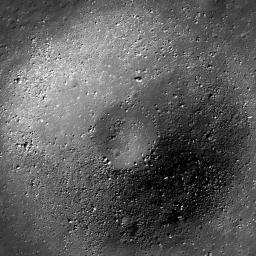Small Crater in Oceanus Procellarum
Caption:
This unnamed 740 meter diameter crater has bouldery walls and is morphologically similar to many <1 km diameter craters in the mare. Image width is 847 meters, LROC NAC M127328861L.
The LROC NAC has imaged thousands of blocky craters similar to this example found in Oceanus Procellarum. The numerous boulders may be fragments of bedrock, regolith breccias formed by the impact itself, or a combination of both. Since a crater depth of excavation is roughly one tenth its diameter, this small crater has probably distributed material from about 75 meters depth around its rim. Usually, ejecta material on the rim comes from the deepest part of the crater, and ejecta farther away from the crater comes from shallower depths. Thus astronauts can walk towards a crater rim, sampling material from greater depths as the rim is approached in a radial cross-section of the ejecta blanket. As you look at these boulders, you are witnessing a history of the emplacement of this mare. If we could just pick up samples and bring them back to Earth, we could figure out how much time elapsed between mare basalt flows in this area and how much the composition changed with time.

|
|
Click on image for larger version
|
|
|
The vast Oceanus Procellarum mare basalts are observed in this portion of LROC Wide Angle Camera monochrome M117895651M. Prominent across the scene are wrinkle ridges and secondary crater clusters. The arrow points to the blocky crater in the opening image
|
|
Background Info:
NASA's Goddard Space Flight Center built and manages the mission for the Exploration Systems Mission Directorate at NASA Headquarters in Washington. The Lunar Reconnaissance Orbiter Camera was designed to acquire data for landing site certification and to conduct polar illumination studies and global mapping. Operated by Arizona State University, LROC consists of a pair of narrow-angle cameras (NAC) and a single wide-angle camera (WAC). The mission is expected to return over 70 terabytes of image data.
Cataloging Keywords:
| Name |
Value |
Additional Values |
| Target |
Moon |
|
| System |
Earth |
|
| Target Type |
Satellite |
|
| Mission |
Lunar Reconnaissance Orbiter (LRO) |
|
| Instrument Host |
Lunar Reconnaissance Orbiter |
|
| Host Type |
Orbiter |
|
| Instrument |
Lunar Reconnaissance Orbiter Camera (NAC) |
|
| Detector |
|
Narrow Angle Camera (NAC), Wide Angle Camera (WAC) |
| Extra Keywords |
Crater, Grayscale, Impact |
| Acquisition Date |
|
| Release Date |
2011-03-22 |
| Date in Caption |
|
|
| Image Credit |
NASA/GSFC/Arizona State University |
| Source |
photojournal.jpl.nasa.gov/catalog/PIA14026 |
| Identifier |
PIA14026 |


